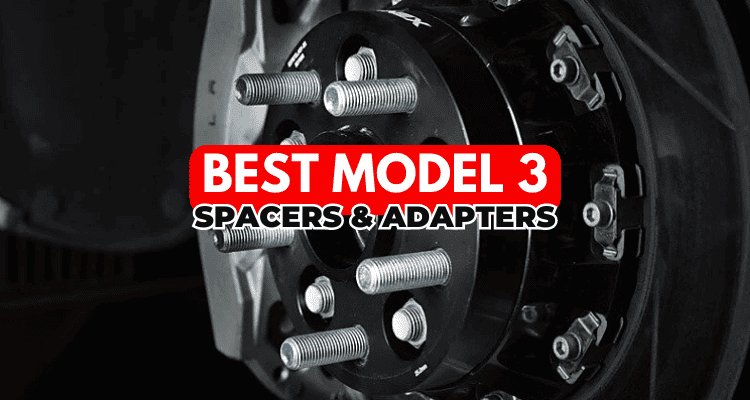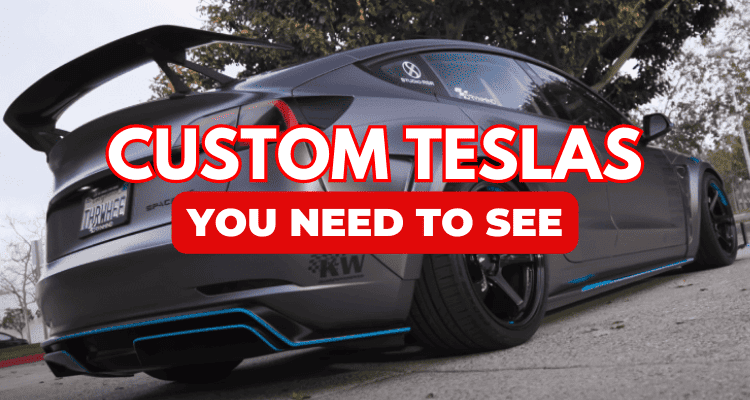How to Lower Tesla Model 3 – Springs vs Coilovers
Some of the links in this article are "affiliate links", a link with a special tracking code. This means if you click on an affiliate link and purchase the item, we will receive an affiliate commission.
The price of the item is the same whether it is an affiliate link or not. Regardless, we only recommend products or services we believe will add value to our readers.
By using the affiliate links, you are helping support our Website, and we genuinely appreciate your support.
Continuing my Tesla customization series, I’m tackling the question on many owners’ minds: How to Lower Tesla Model 3?
I’ll cover the pros and cons of getting a Model 3 lowered. Explain the differences between lowering springs and coilovers. Touch upon the pricing.

By the end, you should have most, if not all, of your Tesla Model 3 lowering-related questions answered and be able to make an informed decision.
I promise to keep it simple. Let’s get started.
Why Lower Your Tesla Model 3?
When it comes to factory suspension, there is one thing that most Tesla Model 3 owners would agree on. The ride quality feels somehow inconsistent, and that’s why lowering the car is a hot topic.
Before we dive into the specifics of lowering springs and coilovers, let’s quickly look at the benefits and drawbacks of lowering a Tesla Model 3. Trust me; you don’t want to jump into this mod blindly without first weighing the pros and cons.
Benefits of a Lowered Model 3
There is tons of information online, so I see no reason to get into too much detail. I want to help you set the right expectations without making things complicated. So here are the main pros of getting your Tesla lowered.

Enhanced Aesthetics
With a lower ride height, your Model 3 will appear more aggressively. A lowered Tesla with a set of nice aftermarket wheels looks more in tune with the modern automotive scene.
By the way, here is a fitment guide on Model 3 factory and aftermarket wheels.
Lower Center of Gravity
Lowering your Tesla Model 3 will also impact the center of gravity, reducing the car’s weight transfer. This translates into a better experience behind the wheel when accelerating and braking.
Reduced Body Roll
A lower center of gravity also means less body roll during hard cornering and improved stability at high speeds. Teslas are very quick, but other than that, they don’t really behave like sports cars.
Drawbacks of Lowering a Model 3
When I say drawbacks, I don’t mean to change your mind. My Model 3 is also lowered, and I’m happy with it. I just feel obliged to tell you about the potential issues.
Reduced Ground Clearance
The first thing to consider when lowering a Tesla is ground clearance. If the roads in your area are in poor condition, make sure you choose the appropriate ride height. In other words, don’t go too low.
Scraping the Bottom
Lowering your Model 3 too much can be problematic when navigating speed bumps, potholes, or steep driveways on a daily basis. It’s very easy to hit the bottom of the car. If it happens often, it’ll damage the vehicle.
Suspension Wear & Tear
The suspension works harder to maintain ride comfort when your Tesla is lowered. Suspension components can wear out faster, especially if you buy cheap mods. Always go for reputable brands and products with positive feedback.
Lowering Springs vs Coilovers

Long story short, if you’re not planning to hit the race track with your Tesla, you don’t need coilover suspension.
If you want to get rid of the wheel gap and have your Model 3 look and feel more sporty, buy a set of springs and enjoy your car.
I can give you two tips based on my experience with modifying dozens of cars over the years. And those apply even more to Teslas.
1. The more complicated the upgrade, the more headaches.
2. Never go for budget suspension upgrades (springs or coilovers).
Springs for Tesla Model 3
As a Tesla Model 3 owner, you probably know that lowering springs are arguably the most popular upgrade. Lowering springs are affordable, easy to install, and usually don’t require any further altering of your vehicle.
Now, I said usually because manufacturers often recommend changing the shocks. I’ve also seen Tesla Model 3 owners cutting the factory bump rubber when installing aftermarket springs to prevent shocks from bottoming out.
I lowered my Model 3 with Eibach’s Pro Kit without doing any tweaks. So far, so good. Enjoying a smooth and comfortable ride for years with no issues. Of course, there are other good brands to consider.
Lowering Springs Pros & Cons
Pros
Cons
Coilovers for Model 3
Now, let’s talk about coilover kits for Tesla Model 3. While lowering springs are mainly for looks (unless combined with sway bars), coilovers will give you more of the benefits I mentioned earlier. However, top-quality products like KW or ÖHLINS are ten times more expensive.
As K-Sport USA discusses in their article, spring rates, valving adjustability, top mounts, and monotube/twin-tube design are the most important factors to consider when shopping for coilover suspension.
So, what do you get when paying big bucks for good coilovers? First thing first, you can adjust the ride height. That’s very important if you plan to buy a bigger set of wheels. Having control over the drop avoids the risk of rubbing the tires against your fenders.
Most coilover kits also come with adjustable dampers, allowing you to set the ride quality according to your preferences. Improving the aerodynamics of your Model 3, a specifically engineered coilover system also increases range (potentially).
As opposed to installing springs, upgrading your Model 3 with coilovers means changing more suspension components. This often causes rattles and squeaks. While you won’t notice it in gas-powered vehicles, you’ll certainly hear it in your quiet Tesla.
Coilovers Pros & Cons
Pros
Cons
Model 3 Lowering FAQ
Now that you are more familiar with the pros and cons of lowering a Tesla M3, let’s answer some questions to help you make an informed decision. If you want to learn more about other customization options, check out this article.
Is It Safe to Lower a Model 3?
Lowering the car will affect its handling and ride quality, but it’s safe if done properly and with the right equipment. To avoid any problems, use high-quality springs or coilovers specifically designed for the Model 3.
It’s recommended to have them installed by a professional who is experienced with lowering cars. It’s also important to ensure that the alignment is properly adjusted after the installation to maintain the car’s handling and stability.
Can I Install Springs or Coilovers Myself?
Yes, it is possible to install springs or coilovers on a Tesla Model 3 yourself. Keep in mind that if not done properly, the suspension mods can negatively impact your car’s handling, ride quality, safety, and resale value.
Additionally, improper installation can lead to premature wear and tear on other suspension components. So, even if you feel confident doing it, having a professional check your work is recommended to ensure the installation is done correctly.
What is the Ideal Height to Lower a Model 3?
The ideal height depends on your preference and the desired look and performance. Generally, a 1-2 inches drop is considered a good balance between appearance and ride quality. If you want to go lower, consider road quality and wheel/tire size, and get advice from a mechanic.
Does Lowering a Model 3 Affect Range?
Generally speaking, lowering your Tesla Model 3 will reduce the car’s drag and improves its range. Tuning companies like Unplugged Performance focusing on Model 3 performance upgrades have proved it with various tests.
However, you must spend a lot on aerodynamics and weight reduction to achieve noticeable results. Installing only lowering springs or coilovers won’t move the needle. Premium carbon fiber mods and body kits will do.
Will Lowering My Model 3 Affect Its Warranty?
It depends on the specific modifications made and the policies of the dealership or manufacturer. Some Tesla dealerships may allow certain mods, while others may not. Any problems arising from your Model 3 being lowered may not be covered under the warranty. So, it’s always better to consult with them first.
In general, using springs that are designed for your car won’t cause any issues as you won’t have to change anything else. When lowering your Model 3 with a coilover kit, you’ll also have to replace other suspension components, and your warranty might get voided.
How Much Does It Cost to Lower Tesla Model 3?
The cost of lowering a Model 3 will depend on your goals and budget. As I explained in the article, there are only two ways to go:
Option 1: Lowering springs is the better option if you only want to enhance the car’s appearance and enjoy a comfortable ride. A set of 4 good-quality springs from a reputable company will cost you between $350 and $650.
Option 2: To improve performance and handling and adjust the ride quality of a Tesla Model 3, you need coilovers. Your preferences will determine the cost.
Street Driving: Good quality coilover kits are in the low to mid $1,000 range.
Road & Track: Ultimate street driving & track capabilities will cost you $3,000+.
Pro Racing: Not many options, and the price varies between $5,000 and $15,000.
*All prices I mentioned above are for the products only. If you cannot install the parts yourself, you must add the labor to the total cost. The average mechanic hourly rate these days is $100, with 3 to 5 hours needed for the job.
My Last Thoughts
As with all my Tesla articles, my goal is not to convince you that a particular modification is right for your car. I always share my personal experience and knowledge based on research to help you make an informed decision.
I have lowering springs and wheel spacers on my Tesla Model 3 because I focus on appearance and ride comfort. If your goal is an ultimate driving experience, then coilovers along with light wheels, low profile tires, and perhaps a brakes upgrade is what you need.
So whether you are just about aesthetics or seeking better performance and handling, I have one piece of advice for you. Always do proper research and never buy cheap mods.
Tesla Model 3 is getting more popular, which leads to more poor-quality modifications on the market. On top of that, many websites speculate on the price of parts and accessories.
If you want to make your EV a real head-turner, my Best Tesla Model 3 Mods round-up will help you with that.






